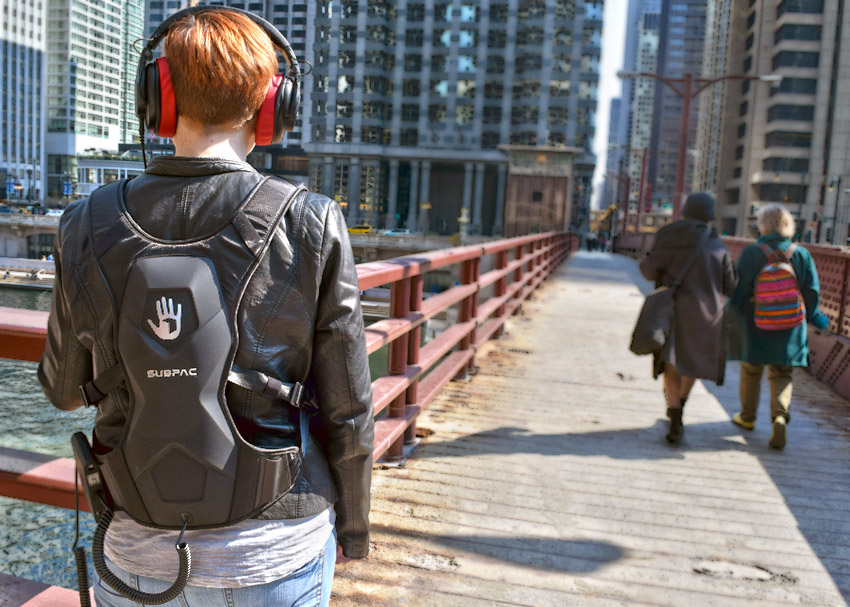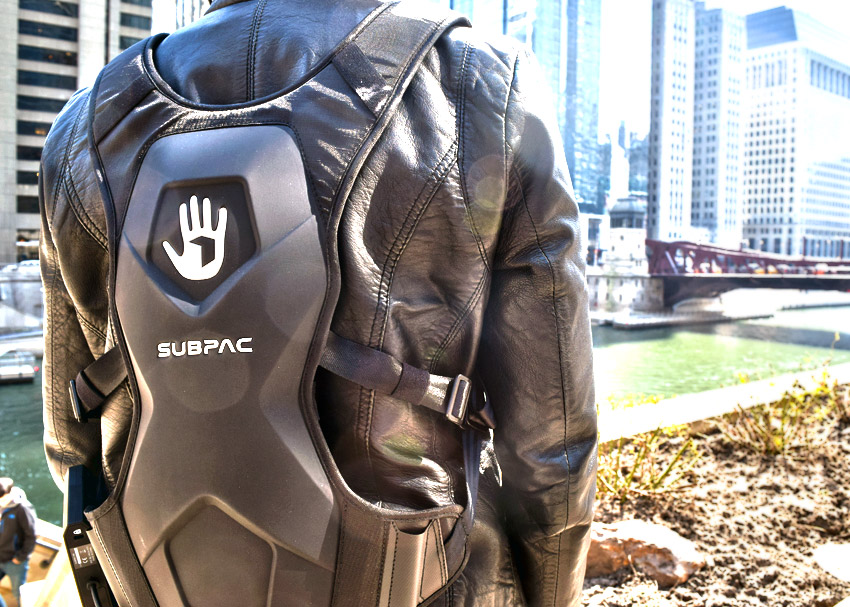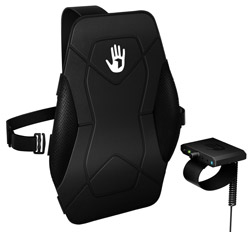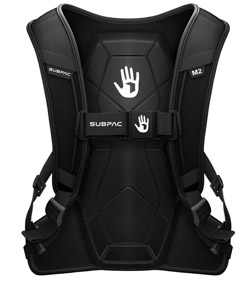What is the SubPac?
If you haven’t heard the buzz, the SubPac Tactile Bass System is, in short, a device that lets you feel sound — specifically the low end of the sonic spectrum, where bass resides. There are two models of the SubPac currently available: the S2 is a stationary unit meant to be strapped to a chair, and the M2 is wearable as a backpack. Both work via embedded transducers that actually pump out the sound — if someone nearby is using a SubPac, you’ll hear muffled bass as if your neighbors are having a party next door. When you wear the SubPac and have headphones in, you’ll feel the bass thump against your back.

We hit the streets with the SubPac M2
The SubPac began as a Kickstarter campaign by a group of artists, entrepreneurs, and engineers collectively called StudioFeed, eventually raising over $100,000 before funding closed in 2013. Since then it’s received a ton of notable endorsements by the likes of Daedalus, George Clinton, and Fatboy Slim. From the first time I heard about the SubPac, I was intrigued. The company’s website includes testimonials from Vice, who called it “the future of music listening,” and WIRED who said it makes music a “full body experience.”
Just a couple of days ago, we got the SubPac S2 and M2 shipped to our office to try out. I opened the S2 box, strapped the unit to my chair, then plugged it into its included control box. The control box includes a power cord out, (our SubPac included several international plug adapters) audio in jack, headphone out jack, on/off switch, and intensity control, which as you might imagine, adjusts the strength of the transducers.
What I was most impressed by was the SubPac’s precision. Different registers of bass sounded…er…felt different. Writing about music gear for a living, the odd art of trying to translate sound into words has left me with a few tropes that translate well. The SubPac reminded me of why these words work. The low mids of guitar and some bass parts really did punch. Kick drums felt like a gut punch. And I could feel sub-bass of a drum machine all over.
I wanted to see how the SubPac would handle different music genres, so I came up with a few tracks to put it through its paces. Check them out, along with notes, below.
Deadmau5 – Some Chords
As someone who was happy to see dubstep’s decline over the last couple of years after an onslaught of wub wub, screech, wub, I knew that testing the SubPac out thoroughly meant I had to revisit the genre. To my surprise, the sustained synth lines that kick off “Some Chords” provided a pleasant pulse to my back, and when the syncopated beats started around 1:37, it felt like a skilled masseuse was working on my back in rhythm. Has EDM ever been this relaxing?
A Tribe Called Quest – Buggin’ Out
How could I not include a track from The Low End Theory on this? Like “Some Chords,” “Buggin Out” begins with a bass line, this time a sample from “Minya’s the Mooch” by Jack Dejohnette’s Directions, played on upright bass and manipulated brilliantly. Sorry, I’m off on a tangent — back to the bassics. What I found cool about listening to this track was that I could feel the resonance of the upright bass by the way the SubPac softened after each note. It was true to the instrument’s character, and I began to see how this could be a useful tool to producers.
Meshuggah – The Demon’s Name is Surveillance
Now it was time to get heavy. I wanted double kick drum, and “The Demon’s Name is Surveillance” by djent pioneers Meshuggah, did not disappoint. The double bass keeps up a relentless assault throughout the song, and the SubPac kept up with every hit. It was less relaxing than the other songs, but still ended up feeling like a consistent heavy massage.
Always (Wave Racer Remix) – Panama
If you’re wondering why all the kids seem to have left dubstep behind, it’s because they’re into stuff like future bass now. Not surprisingly, it’s a genre that also translates beautifully on the SubPac. With long breaks in-between its bass drops, “Always” left me eagerly anticipating those moments so I could feel them in the SubPac.
Electric Wizard – The Sun Has Turned to Black
Doom metal is another genre known for its low end, but not in the same way as some of the above. On this cut, the SubPac gave an authentic rumble to the downtuned guitar parts, as if I was standing in muddy festival grounds in front of Electric Wizard’s wall of amps. I would have turned the SubPac over to my front to really get a live feel, but I felt weird doing that in my office. Suffice to say, this track showed how the unit can recreate a live show in a pretty cool way.
Nickelback – Photograph
Despite being able to feel the bass, this song was not made any more enjoyable by the SubPac.
Overall Impressions on the SubPac
Listening to some of those tracks with really intricate bass parts, I can see how the S2 could help producers, letting them make better-informed adjustments in the low register and get a feel for how the tracks will translate live. For the casual fan and audiophile, the benefits are pretty obvious. I imagine taking in a concert film, or even watching a movie would be enhanced with a SubPac. In fact, I wouldn’t be too surprised to see high-end theaters use this sort of technology in their seats. I imagine you’d also feel pretty good after having the pulsing bass against your back for 90 minutes or so.
As for the M2, I personally don’t see myself wearing a unit like that in public, but I tend to be a bit of an introvert anyway. Those who don’t mind if others hear the music coming out of their headphones would probably be into the M2, and I can totally see the appeal.
So is the SubPac really “the future of music listening?” In my opinion, not really. But then again, what product ever lives up to being called the future of anything? I will say that my initial reaction of the SubPac being a gimmick was squashed after using it. It is, in fact, a fine-tuned device that works well as a tool for professionals and as a music enhancer for casual use.





